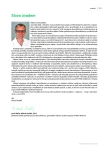Consensus statement of professional associations on prescribing of PCSK9-inhibitors
Authors:
Richard Češka 1; Miloš Táborský 2; Michal Vrablík 3
Authors‘ workplace:
Česká internistická společnost České lékařské společnosti J. E. Purkyně
1; Česká kardiologická společnost
2; Česká společnost pro aterosklerózu
3
Published in:
Vnitř Lék 2018; 64(12): 1131-1136
Category:
News
Overview
A new class of drugs known as PCSK9 inhibitors (PCSK9i) provide biological treatment for hypercholesterolemia. These drugs are administered using a subcutaneous injection once in two or four weeks. PCSK9i are not a replacement of the existing hypolipidemics, they just expand the therapeutic spectrum for the critically ill and those who cannot use the standard therapy and do not reach satisfactory target values. There are essentially two indications: (1) hypercholesterolemie and mixed dyslipidemia and (2) secondary prevention of cardiovascular diseases (CVD). Statin intolerance is not the only indication for treatment. However as its presence sometimes plays an essential role as to choosing the treatment, it will be also discussed in the paragraph on reimbursement conditions. Reimbursement conditions (very simplified): the treatment will be provided at selected centres. A list of the centres is included in an annexe to this article. You will find it also on www.interna-cz.eu, on www.kardio-cz.cz and www.athero.cz. The indicative concentration of LDL-cholesterol (LDL-C) from which on PCSK9i can be prescribed as covered from the public health insurance, is the following: (1) familial hypercholesterolemia 4.0 mmol/l, (2) for secondary prevention CVD 3.0 mmol/l – Please note: the presented LDL-C level is one reached under maximum (tolerated) high intensity hypolipidemic therapy. High intensity hypolipidemic therapy is defined as atorvastatin 40–80 mg or rosuvastatin 20–40 mg + ezetimibe. In the case of demonstrated intolerance of both the mentioned statins the patient has to be treated with a maximum tolerated dose of statins, in combination with another hypolipidemic drug (ezetimibe). Statin intolerance is defined as intolerance of at least two successive statins, which results in their discontinuation. Statin intolerance alone is not the indication for PCSK9i treatment! The payment criteria must always be complied with. A medical officer can of course be asked to approve such treatment in exceptional cases.
Key words:
alirocumab – PCSK9 inhibitors centers – center therapy – evolocumab – familial hypercholesterolemia – proprotein konvertase subtilisin kexin 9 inhibitors (PCSK9i) – secondary prevention – statins intolerance
Sources
- Landmesser U, Chapman MJ, Farnier M et al. European Society of Cardiology/European Atherosclerosis Society Task Force consensus statement on proprotein convertase subtilisin/kexin type 9 inhibitors: practical guidance for use in patients at very high cardiovascular risk. Eur Heart J 2017; 38(29): 2245–2255. Dostupné z DOI: <http://dx.doi.org/10.1093/eurheartj/ehw480>.
- Catapano AL, Graham I, De Backer G et al. 2016 ESC/EAS Guidelines for the Management of Dyslipidaemias: The Task Force for the Management of Dyslipidaemias of the European Society of Cardiology (ESC) and European Atherosclerosis Society (EAS). Eur Heart J 2016; 37(39): 2999–3058. Dostupné z DOI: <https://doi.org/10.1093/eurheartj/ehw272>.
- Nordestgaard BG, Chapman MJ, Humphries SE et al. Familial hypercholesterolemia is underdiagnosed and undertreated in the general population: guidance for clinicians to prevent coronary heart disease: consensus statement of the European Atherosclerosis Society. Eur Heart J 2013; 34(45): 3478–3490a. Dostupné z DOI: <http://dx.doi.org/10.1093/eurheartj/eht273>.
- Khera AV, Won HH, Peloso GM et al. Diagnostic yield of sequencing familial hypercholesterolemia genes in patients with severe hypercholesterolemia. J Am Coll Cardiol 2016; 67(22): 2578–2589. Dostupné z DOI: <http://dx.doi.org/10.1016/j.jacc.2016.03.520>.
- Vallejo-Vaz AJ, Kondapally Seshasai SR, Cole D et al. Familial hypercholesterolemia: A global call to arms. Atherosclerosis 2015; 243(1): 257–259. Dostupné z DOI: <http://dx.doi.org/10.1016/j.atherosclerosis.2015.09.021>.
- Watts GF, Gidding S, Wierzbicki AS et al. Integrated guidance on the care of familial hypercholesterolemia from the International FH Foundation. J Clin Lipidol 2014; 8(2): 148–172. Dostupné z DOI: <http://doi: 10.1016/j.jacl.2014.01.002>.
- Češka R et al. Familiární hypercholesterolémie. Triton: Praha 2015. ISBN 978–80–7387–843–6.
Labels
Diabetology Endocrinology Internal medicineArticle was published in
Internal Medicine

2018 Issue 12
Most read in this issue
- Lipoprotein(a) – the cardiovascular risk factor: significance and therapeutic possibilities
- Current views on metabolic syndrome
- Why not to interfere with LDL-cholesterol freefall and why not to talk badly about statins
- Combined lipid-lowering therapy
